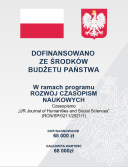Media consumption and communication habits of digital natives living in smaller places. Contribution to historical and media research
DOI:
https://doi.org/10.15584/johass.2022.2.8Keywords:
digital natives, women, smaller towns, quantitative research, media use, media consumptionAbstract
The aim of the article is to present the results of research conducted in 2019 and 2020 to answer the question of how, with what intensity and under what circumstances the perception of media content by digital natives living in smaller towns occurs. The analysis shows that the assumed hypotheses regarding the growing role of social media and internet sources have been confirmed. Importantly, in the opinion of the respondents, also the traditional media, i.e. radio and television, are a valuable source of information and entertainment for women whose opportunities to participate in culture are limited by their chosen place of residence. The analyzed data also shows that traditional linear television, sometimes referred to as programmed television, is being replaced by streaming services, although, as the respondents point out, the most convenient receiving device is still a television set. The results of radio listenership are also similar to the national results. A small percentage of readers of the daily press and magazines is also a nationwide trend, especially in the studied demographic, although attachment to reading the press during trips or holidays is an interesting phenomenon that is currently the object of in-depth description in the extended research conducted by the author. The presented data are preliminary studies necessary to expand and discuss future methods and goals.Downloads
Download data is not yet available.
Downloads
Published
2022-06-30
How to Cite
Kinal, J. (2022). Media consumption and communication habits of digital natives
living in smaller places. Contribution to historical and media research. Journal of Humanities and Social Sciences, 23(2), 135–146. https://doi.org/10.15584/johass.2022.2.8
Issue
Section
Articles
License
Copyright (c) 2022 Wydawnictwo Uniwersytetu Rzeszowskiego

This work is licensed under a Creative Commons Attribution-NonCommercial 4.0 International License.



